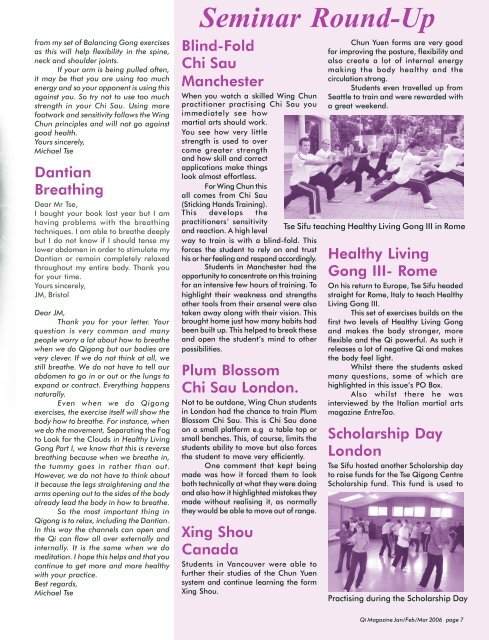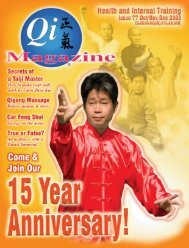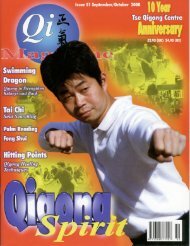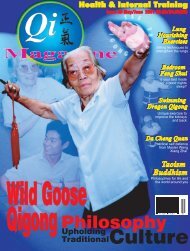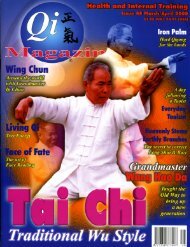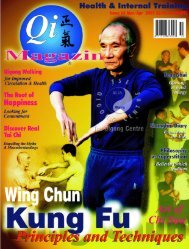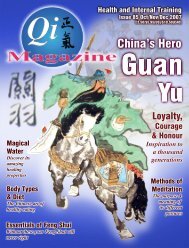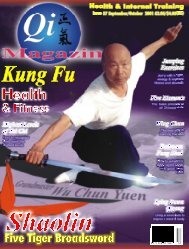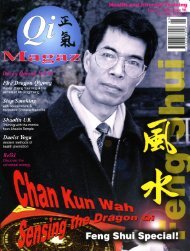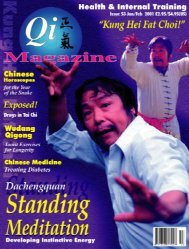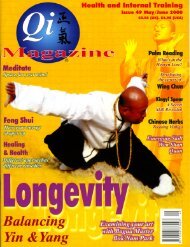Issue 78 - Tse Qigong Centre
Issue 78 - Tse Qigong Centre
Issue 78 - Tse Qigong Centre
- TAGS
- issue
- qigong
- qimagazine.com
Create successful ePaper yourself
Turn your PDF publications into a flip-book with our unique Google optimized e-Paper software.
from my set of Balancing Gong exercises<br />
as this will help flexibility in the spine,<br />
neck and shoulder joints.<br />
If your arm is being pulled often,<br />
it may be that you are using too much<br />
energy and so your opponent is using this<br />
against you. So try not to use too much<br />
strength in your Chi Sau. Using more<br />
footwork and sensitivity follows the Wing<br />
Chun principles and will not go against<br />
good health.<br />
Yours sincerely,<br />
Michael <strong>Tse</strong><br />
Dantian<br />
Breathing<br />
Dear Mr <strong>Tse</strong>,<br />
I bought your book last year but I am<br />
having problems with the breathing<br />
techniques. I am able to breathe deeply<br />
but I do not know if I should tense my<br />
lower abdomen in order to stimulate my<br />
Dantian or remain completely relaxed<br />
throughout my entire body. Thank you<br />
for your time.<br />
Yours sincerely,<br />
JM, Bristol<br />
Dear JM,<br />
Thank you for your letter. Your<br />
question is very common and many<br />
people worry a lot about how to breathe<br />
when we do <strong>Qigong</strong> but our bodies are<br />
very clever. If we do not think at all, we<br />
still breathe. We do not have to tell our<br />
abdomen to go in or out or the lungs to<br />
expand or contract. Everything happens<br />
naturally.<br />
Even when we do <strong>Qigong</strong><br />
exercises, the exercise itself will show the<br />
body how to breathe. For instance, when<br />
we do the movement, Separating the Fog<br />
to Look for the Clouds in Healthy Living<br />
Gong Part I, we know that this is reverse<br />
breathing because when we breathe in,<br />
the tummy goes in rather than out.<br />
However, we do not have to think about<br />
it because the legs straightening and the<br />
arms opening out to the sides of the body<br />
already lead the body in how to breathe.<br />
So the most important thing in<br />
<strong>Qigong</strong> is to relax, including the Dantian.<br />
In this way the channels can open and<br />
the Qi can flow all over externally and<br />
internally. It is the same when we do<br />
meditation. I hope this helps and that you<br />
continue to get more and more healthy<br />
with your practice.<br />
Best regards,<br />
Michael <strong>Tse</strong><br />
Seminar Round-Up<br />
Blind-Fold<br />
Chi Sau<br />
Manchester<br />
When you watch a skilled Wing Chun<br />
practitioner practising Chi Sau you<br />
immediately see how<br />
martial arts should work.<br />
You see how very little<br />
strength is used to over<br />
come greater strength<br />
and how skill and correct<br />
applications make things<br />
look almost effortless.<br />
For Wing Chun this<br />
all comes from Chi Sau<br />
(Sticking Hands Training).<br />
This develops the<br />
practitioners’ sensitivity<br />
and reaction. A high level<br />
way to train is with a blind-fold. This<br />
forces the student to rely on and trust<br />
his or her feeling and respond accordingly.<br />
Students in Manchester had the<br />
opportunity to concentrate on this training<br />
for an intensive few hours of training. To<br />
highlight their weakness and strengths<br />
other tools from their arsenal were also<br />
taken away along with their vision. This<br />
brought home just how many habits had<br />
been built up. This helped to break these<br />
and open the student’s mind to other<br />
possibilities.<br />
Plum Blossom<br />
Chi Sau London.<br />
Not to be outdone, Wing Chun students<br />
in London had the chance to train Plum<br />
Blossom Chi Sau. This is Chi Sau done<br />
on a small platform e.g a table top or<br />
small benches. This, of course, limits the<br />
students ability to move but also forces<br />
the student to move very efficiently.<br />
One comment that kept being<br />
made was how it forced them to look<br />
both technically at what they were doing<br />
and also how it highlighted mistakes they<br />
made without realising it, as normally<br />
they would be able to move out of range.<br />
Xing Shou<br />
Canada<br />
Students in Vancouver were able to<br />
further their studies of the Chun Yuen<br />
system and continue learning the form<br />
Xing Shou.<br />
Chun Yuen forms are very good<br />
for improving the posture, flexibility and<br />
also create a lot of internal energy<br />
making the body healthy and the<br />
circulation strong.<br />
Students even travelled up from<br />
Seattle to train and were rewarded with<br />
a great weekend.<br />
<strong>Tse</strong> Sifu teaching Healthy Living Gong III in Rome<br />
Healthy Living<br />
Gong III- Rome<br />
On his return to Europe, <strong>Tse</strong> Sifu headed<br />
straight for Rome, Italy to teach Healthy<br />
Living Gong III.<br />
This set of exercises builds on the<br />
first two levels of Healthy Living Gong<br />
and makes the body stronger, more<br />
flexible and the Qi powerful. As such it<br />
releases a lot of negative Qi and makes<br />
the body feel light.<br />
Whilst there the students asked<br />
many questions, some of which are<br />
highlighted in this issue’s PO Box.<br />
Also whilst there he was<br />
interviewed by the Italian martial arts<br />
magazine EntreTao.<br />
Scholarship Day<br />
London<br />
<strong>Tse</strong> Sifu hosted another Scholarship day<br />
to raise funds for the <strong>Tse</strong> <strong>Qigong</strong> <strong>Centre</strong><br />
Scholarship fund. This fund is used to<br />
Practising during the Scholarship Day<br />
Qi Magazine Jan/Feb/Mar 2006 page 7


